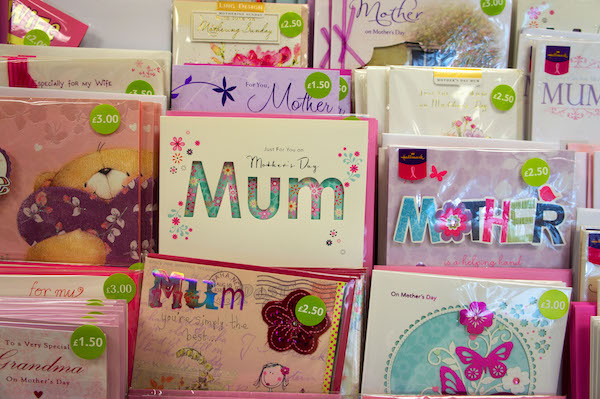The fourth Sunday in Lent is Laetare or “Rejoice” Sunday, named for the first word of the entrance antiphon: “Rejoice, Jerusalem, and all who love her”. Instead of purple, the priest wears pink vestments (if available).
It’s a day of rejoicing, slap bang in the middle of Lent, just as the gloom is beginning to thicken, and it can take you aback.
It’s also known as “Mothering Sunday”, and since the Middle Ages has been a time when people visited or commemorated the church where they were baptised. This seems to be one of the traditions kept by Anglicans after the Reformation, but not so much by Catholics, for whom, of course, it had become very tricky.
There’s a corresponding Sunday in Advent (the third of the four), but that one is Gaudete Sunday, because that’s the first word of the entrance antiphon, which means the same thing. That’s why one candle on the Advent wreath may be pink, and again you can have pink vestments.
Because Advent is shorter and more cheerful generally, it’s a bit less of a shock. Both Pink Sundays make me feel I should have been being gloomier in the run-up to them, as they are a rare, deliberate relaxation of the rules of the season.
If Mothering Sunday had originally been a feast focussing on Our Lady as an actual mother, I suspect it would be a bigger Catholic feast; but then it probably wouldn’t happen in the middle of Lent. If the Annunciation falls in Holy Week, the whole feast gets moved, but Mothering Sunday is always in Lent.
To confuse things still further, after an American campaign to create “Mother’s Day” as a celebration in its own right, an Englishwoman (Constance Adelaide Smith) decided to revive the mediaeval tradition over here, recasting it as a fourfold celebration of Mother Church, mothers of earthly homes, the mother of Jesus, and gifts of Mother Earth. That list looks a bit Arts-and-Crafts Movement to me. Her booklet on this, The Revival of Mothering Sunday, was published in 1921.
People liked the idea – by the 1950s it was popular, and then the greetings card industry and retailers in general jumped on the bandwagon, and nowadays you can’t avoid references to it everywhere.
I have sat through several sermons (in Catholic churches), explaining that Mother’s Day is in fact all about the Church and Church buildings. I put them in the same mental box as the sermons on the feast of the Holy Family explaining that the real family in question is the Trinity (I am not making this up).
Whatever the history of Mother’s Day, I think it’s a good idea at both the Church and human level, but there is absolutely no textual support for it in the current Catholic tradition.
The Anglican lectionary still has readings which are (very) roughly relevant – Paul on Hagar versus Sarah in Galatians 4, Psalm 122/123 processing joyfully to God’s house – but the Catholic one does not.
I think this may be why I’ve always understood that Mother’s Day nowadays was purely secular. I knew about the mediaeval links about visiting your baptismal church and so on, but there was absolutely nothing in the Catholic Sunday readings for the Fourth Sunday of Lent to pick up a maternal theme.
I was so surprised by this that I checked for all three years of the lectionary, and it’s totally consistent. The only piece of text common to all three Sundays and the Anglican Lectionary is the entrance antiphon, “Rejoice, Jerusalem”, so it’s not surprising that it’s called Laetare Sunday, but the Mother’s Day connection is far more tenuous.
Indeed, the readings manage to exclude women almost entirely.
Year A has the choice of David out of all his brothers, with an all-male cast, and the Gospel is the one about the man blind from birth, where his mother has a walk-on part as one half of the parents who might have sinned to cause their son’s blindness (Jesus rejects this idea), and who then refuse to answer questions because they are afraid of the authorities.
Year B has the sack of Jerusalem and victory of Nebuchadnezzar, followed by Jesus’ conversation with Nicodemus, where they discuss the concept of being born again, so “his mother’s womb” is mentioned, but that’s it.
Year C has the end of the manna as the Israelites start living off the land in Canaan, followed by the Prodigal Son, a story which features no females except the harlots.
I think we have perforce to distinguish between Mothering Sunday as a historical precedent and locator, and the modern Mother’s Day, which is not churchy at all. The shops are full of displays for Mother’s Day, very similar to the Easter designs, lots of pastel colours, flowers, cakes and sweeties (slightly fewer rabbits, which is a relief).
The word “Mum” (or even worse “mum”) gets bandied around far too freely. If you actually meant it, you’d be using it for your own mother; if you don’t mean it, it’s impertinent. My loathing of the generic usage of ‘mum’ goes back to my first pregnancy, and I remember being annoyed enough by it to object to being addressed like that even during labour. Only six children are supposed to use it about me, and they know enough to replace it with “Mummy” (or “Mother” for John, who is hyper-sensitive. Like his mother.).
I think it’s interesting to note that the cards and advertising do all use what you might call old-fashioned gender language. You hear about some hospitals or clinics referring to birthing parents, but I haven’t seen any cards saying that. Although last year Mary found one that said, “Mum, you’re one of my favourite parents”, which I assume was meant for a family with more than the usual two. She bought it for me just to watch me cringe.
One reason why small children are aware of Mother’s Day (and where do you put the apostrophe? The whole subject is full of questions!) is because it’s one of the topics where they are encouraged to make cards at school. I still have some elderly but cherished ones acting as bookmarks in recipe books, which is a very good thing to do with them, as it’s always a pleasure to find them.
And it can embarrass the boys dreadfully. Edmund made me a lovely one when he was seven, shaped like a teapot, coloured to match my willow pattern pot, and with a teabag sellotaped by its tag to the card, encouraging me to enjoy a break on Mother’s Day. We thought that was very imaginative of the teacher.
Most of the cards just have little poems inside (which I also love, but at which the children pretend to squirm). I’m much happier with cards for Mother’s Day than with Valentine cards, which I think are daft and inappropriate for small children, but I have to cut the teachers some slack, because you can have the whole class doing cards only for events which cover everyone, so birthdays don’t work.
I haven’t seen any cards obviously seeking to avoid the words Mother or Mum, but I have had a few marketing emails telling me that I can opt out of Mother’s Day mailings if they are painful. After years of carefully noticing Mother’s Day first to remind me to send flowers to my own mother, then some more years reminding me to remind my husband to send them to his mother, and then several just duplicating the cards and flowers myself because it saved time, it is sad when you don’t have either mother to send them to any more. But I positively like to be reminded, because it’s always a pleasure to think of my mother and my mother-in-law.
It must be painful for people without children, but I know Rachel sent a Mother’s Day card to my sister when we were out of the country and Susan had taken on the responsibilities of a legal guardian. I thought that was a lovely thing for Rachel to have done, and I know that Susan was very touched. I wonder how many people receive similar stand-in Mother’s Day cards.
I hope somebody does a range of stepmother cards, because I think it might be fun to play with the iconography, and at least it wouldn’t always be pastels. You would need to be careful. But it would be good to recognise the loving effort put in by so many stepmothers, often in very difficult circumstances.
Celebrating mothers of all types is a good idea, because it’s easy for them to feel taken for granted. My own mother always used to tell us that she would have had a medal in many (communist) countries to show appreciation of her work (there were seven of us), and we joked about a nappy pin in gold being the best medal.
I think the most appreciated way to celebrate someone is just a message or a phone call (visits are also lovely, but often not practical). And even though it’s Lent, traditionally the rules are eased for a feast, so chocolates or cakes don’t have to be postponed until Easter.
In the days of paper newspapers, I used to collect headlines either with the children’s names in them (if there’s a royal or a celebrity, this can be a rich source), or just ones that struck me as funny, and we have three big posters covered in them, now curling at the edges and going brown, but still riveting.
My husband has always liked the one that says “Mother’s Day in Bath”. A girl can always dream... One of my favourites says “The fact that she was Catholic did not stop her having fun”. I just wish I could remember the context, but I strongly agree with the sentiment.
Kate Keefe composes musical settings for the Mass and writes about the psalms. You can follow her on Facebook, Twitter and LinkedIn.



 Loading ...
Loading ...
What do you think?
You can post as a subscriber user ...
User comments (0)